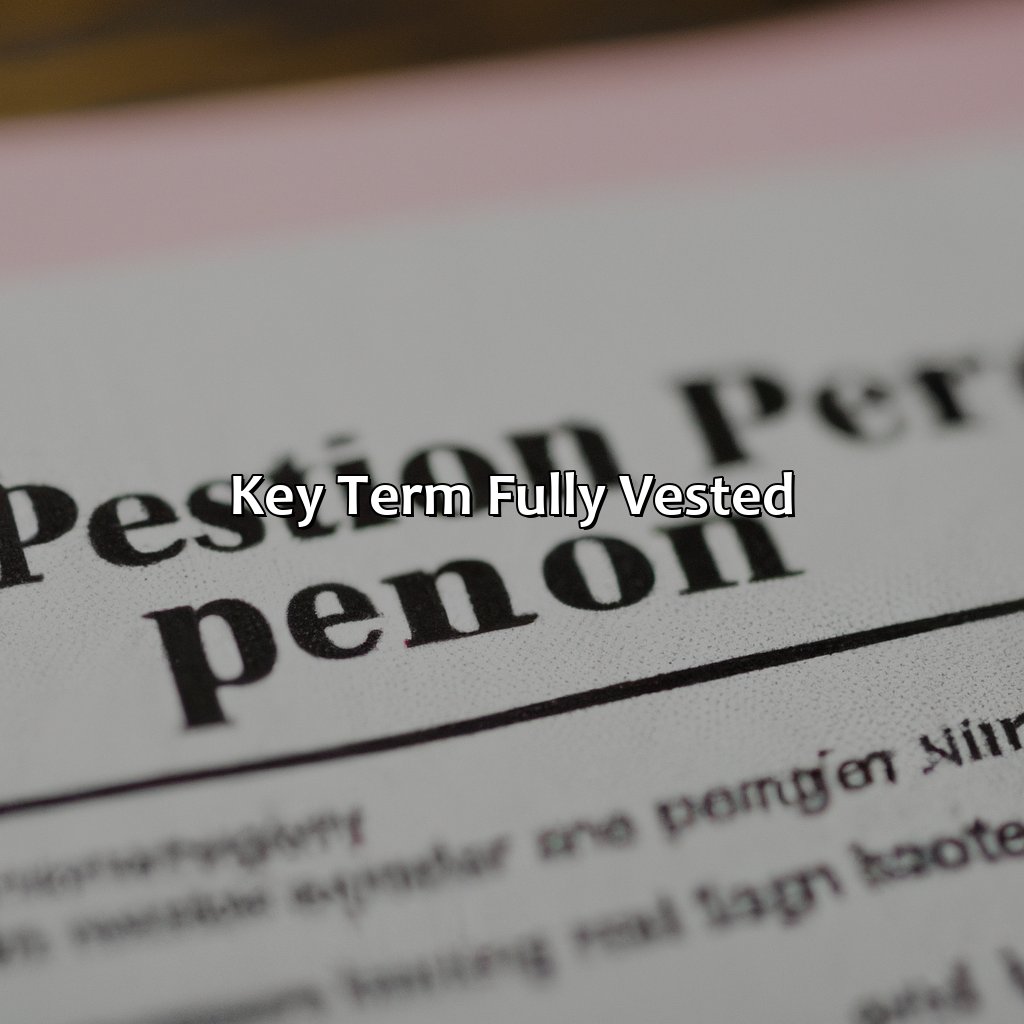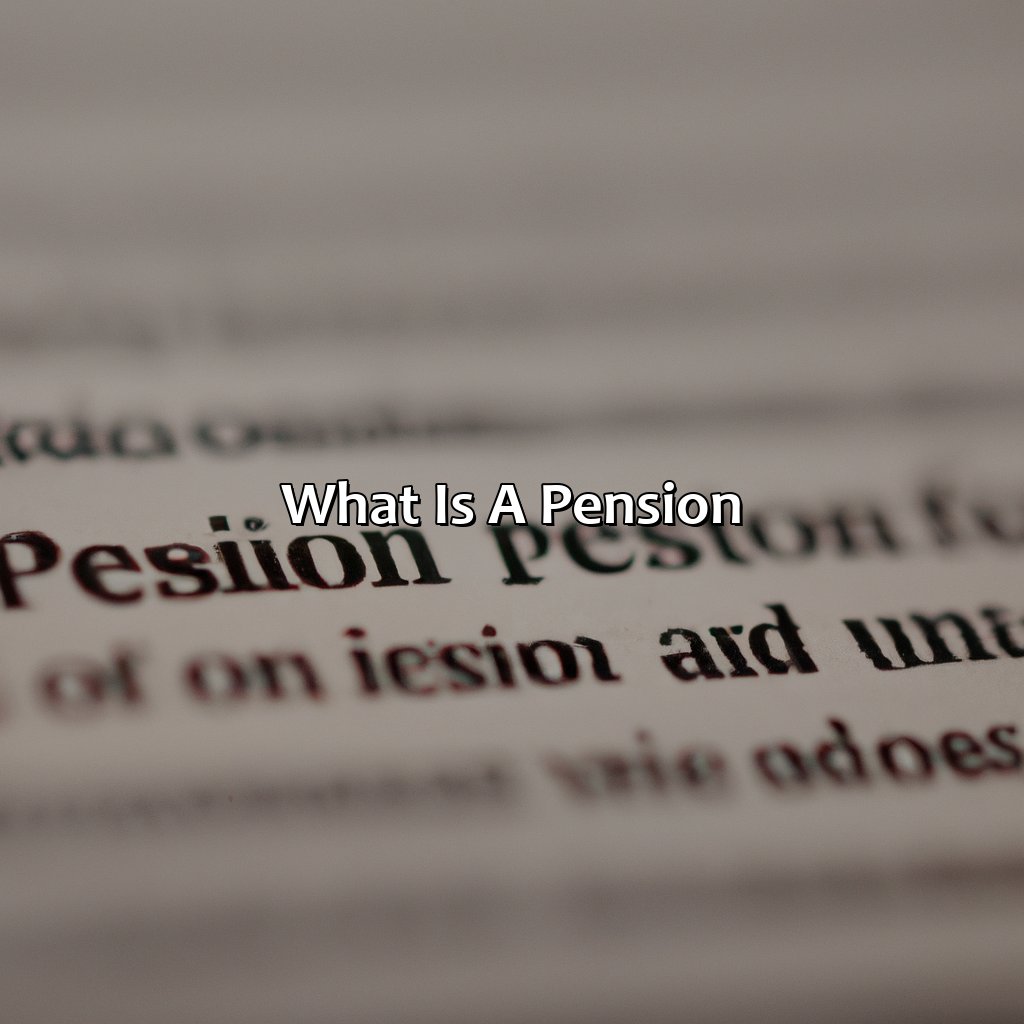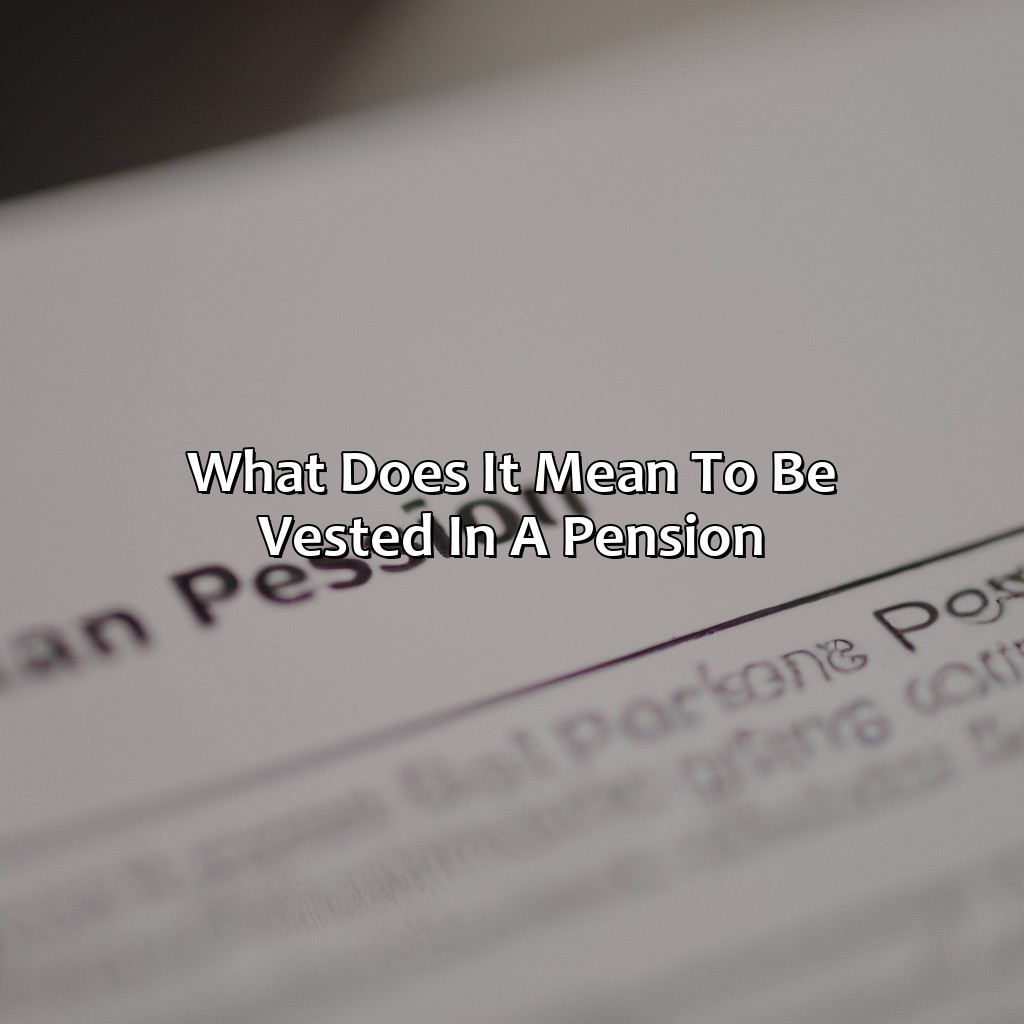What Does It Mean To Be Fully Vested In A Pension?
Key Takeaway:
- Fully vested means that an individual has met the requirements to have 100% ownership and access to the funds in their pension account, regardless of future employment status.
- A pension is a retirement plan that is funded by an employer or employee and provides a specified monthly income to the retiree. A pension is typically defined benefit, meaning that the employer guarantees a specific benefit payment based on factors such as length of service and salary history.
- Vesting in a pension refers to the process of earning ownership and access to the funds in the account. There are different types of vesting, but being fully vested means the individual has met all requirements to access all funds in their pension account.
- Being fully vested in a pension is important because it guarantees access to funds and any employer contributions. Without full vesting, an individual may forfeit some of their retirement savings if they leave their employer before becoming fully vested.
- To achieve full vesting, an individual must meet eligibility requirements and remain employed for a certain amount of time. The timeframe for full vesting varies depending on the pension plan.
Are you worried about your retirement plan? Do you know what it takes to be fully vested in a pension plan? Discover the ins and outs of pension plans, so you can be ready for the future. You will understand what exactly it means to be fully vested.
Key term: “Fully Vested”
Fully Vested: Understanding the Meaning of Being Fully Entitled to Your Pension Benefits
Being fully vested in a pension plan means that you have earned the right to the full value of your pension benefits. In other words, you have reached the point where you are entitled to receive all of the contributions made by your employer on your behalf, as well as any earnings that may have accrued over time.
In order to become fully vested, you need to satisfy the requirements of your pension plan. These can include meeting certain age and service criteria, as well as other conditions that may be outlined in your plan documents. Once you meet these requirements, you become fully vested and can begin receiving your pension benefits.
It is worth noting that the process of becoming fully vested can vary significantly depending on the type of pension plan you have. For example, some plans may have vesting schedules that require you to work for a certain number of years before you become fully vested. Others may have different criteria altogether. It is important to review the terms of your specific plan to understand exactly what is required.
When it comes to the history of pension plans, the idea of vesting has been around for a long time. In fact, some of the earliest pension plans required employees to work for their employers for 20 years or more before they were entitled to receive any benefits. Over time, this has changed and many plans now allow employees to become fully vested much more quickly.
Overall, understanding what it means to be fully vested in a pension plan is an important part of planning for your retirement. Whether you are just starting out in your career or have been working for many years, taking the time to understand your pension plan and its vesting requirements can help you make informed decisions about your financial future.

Image credits: retiregenz.com by David Arnold
What is a Pension?
Do you know what a pension is and how it works? Let’s break it down. How does a pension operate? What are the advantages for you? This section will provide insight; so you can gain a clearer comprehension of your retirement plan.

Image credits: retiregenz.com by Harry Arnold
How does a Pension Work?
Retirement pensions are designed to provide financial benefits to employees who have worked for an organization for a certain number of years. These pensions are funded by employers and/or employees, and payments are made to retirees on a regular basis after they stop working. The amount of payment a retiree will receive often depends upon their salary history, years of service, and whether they are fully vested in the pension plan.
Once an employee is fully vested in a pension plan, they are entitled to receive their full benefit amount, regardless of whether or not they continue working for that organization. Vesting typically requires a certain number of years of service with an employer, such as five years. During this time, if an employee leaves the company before becoming fully vested, they may forfeit some or all of their employer-contributed pension funds. If you’re curious about what a pension check is and how it works, do check out our article on it.
It’s important to note that while some pensions provide cost-of-living adjustments to adjust for inflation over time, others do not. Additionally, there are various types of pension plans available, including defined-benefit plans where the benefit amount is predetermined based on factors such as salary and years of service.
Pro Tip: It’s crucial to fully understand the terms and conditions of your employer-sponsored retirement program so you can plan accordingly for your financial future.
Being fully vested in a pension is like having a guaranteed retirement fund, unless of course the world ends before then.
What Does it Mean to be Vested in a Pension?
To know about pension vesting, you have to dive into two parts: Types of Vesting and Fully Vested Defined. These will give you an insight into the workings of pensions and how they can benefit you. Understanding this is essential.

Image credits: retiregenz.com by Joel Woodhock
Types of Vesting
Different Forms of Pension Vested Status
In the pension system, there are different forms of vested status which determines an employee’s eligibility to receive pension benefits. Understanding what a pension credit is can help you determine your eligibility and plan for retirement accordingly.
The table below shows the different types of vesting and their corresponding descriptions:
| Type of Vesting | Definition |
|---|---|
| Cliff Vesting | An employer may require an employee to be employed for a specific number of years before becoming 100% vested in their pension plan. This is known as cliff vesting. |
| Graded Vesting | Graded vesting occurs when employees become incrementally vested in their pension benefits over time. |
| Immediate Vesting | With immediate vesting, an employee is entitled to their full pension from their first day on the job. |
It is important to note that some pensions have unique rules or requirements regarding vesting timelines and eligibility which can influence these standard forms.
Pro Tip: Understanding your vested status can help you make informed decisions about your retirement planning. Fully vested means you’re in for the long haul – more committed than a teenager in love, and with less chance of heartbreak.
Fully Vested Defined
When an employee is ‘Fully Vested’ in a pension plan, it means that they have earned the right to receive the entirety of their employer-contributed benefits, regardless of whether they stay with their employer or not. It is an essential term associated with pensions, and it defines the point at which employees have secured the full benefit of their retirement savings.
After completing a certain number of years of service within an organization, usually three to five years, an employee becomes fully vested and gains full ownership of all pension contributions made by the employer. The vested amount can be either a percentage or 100% depending on the vesting schedule that is established as part of the desired plans.
Employers often use differing vesting schedules where employees gradually attain more rights into their own pension plans over time. Vesting schedules are used to encourage long-term loyalty and retention among employees; however, employers can choose to immediately vest or offer partial vestment instead.
A Pro Tip for employees would be to get familiar with your company’s vesting schedule when selecting between job offers longer times taken out are typically worth considering for higher total expected compensation in later stages of employment.
Being fully vested in a pension is like having a guaranteed retirement plan, except without the free early-bird specials and bingo nights.
Importance of Being Fully Vested
It is essential to understand the importance of being fully vested in a pension. Being fully vested means you’ve earned 100% ownership of the money in your account. This affects the amount of funds you can withdraw and the employer contributions you get. Two key sub-sections are:
- Access to funds
- Employer contributions

Image credits: retiregenz.com by James Duncun
Access to Funds
Achieving Full Vested Status: Understanding Pension Fund Withdrawal
If you are fully vested, your pension account is yours to keep. Options to access funds from a pension if you leave before being fully vested may include lump-sum distributions or monthly payments, depending on the terms of the plan. It is important to note that withdrawing funds too early can result in significant tax penalties.
It’s recommended that individuals understand the difference between a pension and 401K, as well as their plan’s vesting guidelines and withdrawal requirements as early as possible. Many plans require a certain number of years of service or age before all funds become fully vested. This information can influence decisions about timing and financial planning for retirement.
By familiarizing yourself with your pension fund policies and seeking professional guidance when needed, you can feel confident about securing your retirement future. Don’t miss out on the benefits of being fully vested by neglecting this crucial aspect of your retirement planning.
Your employer’s contribution to your pension plan is like the cherry on top of your retirement sundae, but only if you’re fully vested and can actually enjoy it.
Employer Contributions
Ascertaining the extent of employer contributions for employee pensions is crucial. Here’s what you need to know about employer pension contributions:
- Employer contributions are funds that an organization contributes to its employees’ pension plans.
- The percentage of contribution varies per sector, collectively agreed upon, or as per an employer’s discretion.
- The usual practice is for the employers to match employee contribution up to a specific limit, which would depend on several factors such as employee status, industry role and regulations set forth by tax bodies or labor authorities.
- Some organizations offer automatic enrollment in their pension scheme for new joiners and may optionally provide a matching contribution amount. Others may request you opt-in to receive this benefit.
- You will typically own all employer contributions made towards your plan based on certain criteria milestones over time. These criteria may include reaching specific years of service or retirement age, regulated as per the legal jurisdiction relevant to the employee’s contractual arrangements with their employer.
- There could be cases where your vesting period reduces if you leave your organization before completing it. The details regarding accelerated vesting after leaving the company reside in most employment agreements or a summary document provided by your HR team upon joining.
Apart from determining actual and contingent worker retirement planning benefits effectively, knowing how much an employer contributes towards your retirement can lead to higher satisfaction levels in the workforce.
Pro Tip: Always keep track of when the vesting period for employer contributions starts rolling and find out what happens if you end up leaving employment before then.
Finally being fully vested in your pension feels like getting promoted from intern to CEO, without the pay raise.
Achieving Full Vesting
For full vesting with your pension plan, you must understand its eligibility requirements and timeframe. This is key! It’ll tell you how much time you need to work for your employer and what % of pension you can get. Digging into the details of eligibility requirements and timeframe for full vesting will give you the info you need. Achieve full vesting!

Image credits: retiregenz.com by Harry Woodhock
Eligibility Requirements
To be eligible for full vesting in a pension plan, an individual must meet certain conditions. These requirements may vary depending on several factors, such as the type of plan and the employer’s policies. Generally, full vesting is achieved when an employee has worked a specified period for the employer. The longer the duration of service with an employer, the higher the possibility of achieving full vesting.
Moreover, other criteria that may determine eligibility include job classification and age. Pension plans may offer different vesting schedules for employees based on their employment status or position within the organization. Additionally, some plans have minimum age requirements that must be met before an employee can become fully vested in a pension.
It is essential to note that once an individual achieves full vesting in a pension plan, they become entitled to receive all benefits accrued during their period of employment. Hence, it is advisable to familiarize oneself with their employers’ policies on pension plans to understand what it takes to achieve full vesting. If you are wondering about widows pension, it is a pension plan available to widows of deceased veterans who served during specific periods of war or conflict.
Pro Tip: To maximize your retirement income potential through your employer’s pension plan, ensure you take appropriate actions that meet your specific needs and circumstances towards achieving full vesting. If only achieving full vesting was as quick and easy as getting dressed in the morning.
Timeframe for Full Vesting
Achieving Full Vesting is the period of time an employee must work to gain 100% access to a pension contribution. In simpler terms, it refers to the length of service required for employees’ entitlement to 100% ownership and control over their retirement benefits. The timeframe for full vesting varies depending on the employer’s policy, but typically ranges from three to seven years.
During this period, employers may also implement graded-vesting schedules where payouts are given incrementally throughout the years rather than all at once after several years of service. Employers may also offer immediate vesting benefits to retain employees or incentivize hires in competitive markets.
There may be some exceptions that allow employees early partial or full vestment in their financial savings plan, such as death, disability or termination due to layoffs or mergers.
To obtain knowledge about the timeframe required for acquiring total pension benefits from your employer, enquire with HR experts and seek professional advice when necessary. Employees need to understand how much retirement money they will be entitled and make decisions based on their long-term financial goals. It’s always important to recognize that investment carries risk, therefore review your accounts regularly with an appropriate advisor for added comfort.
Five Facts About Being Fully Vested in a Pension:
- ✅ Being fully vested in a pension means that you have earned the right to receive the full amount of your pension benefit. (Source: The Balance)
- ✅ Vesting in a pension plan typically takes between three and seven years of service. (Source: Investopedia)
- ✅ Employers may have different vesting schedules, including cliff vesting and graded vesting. (Source: U.S. Department of Labor)
- ✅ Once you are fully vested, you have the right to keep your pension benefit even if you leave your job before retirement age. (Source: Pension Benefit Guaranty Corporation)
- ✅ Pensions are typically funded by both employers and employees, and benefits may be influenced by factors such as years of service and salary history. (Source: Society for Human Resource Management)
FAQs about What Does It Mean To Be Fully Vested In A Pension?
1. What does it mean to be fully vested in a pension?
Being fully vested in a pension means that the employee has earned the right to receive their entire pension benefit amount upon retirement. In other words, the employee has worked long enough for their employer to keep the employer’s contribution made to the pension plan on behalf of that employee.
2. How is vesting different from eligibility to participate in a pension plan?
Vesting refers to the employee’s right to the employer’s contribution to the pension plan, whereas eligibility refers to the employee’s ability to participate in the plan at all. Eligibility criteria such as age and length of service may be required to participate in a plan, but it doesn’t affect the vesting schedule.
3. What is a vesting schedule?
A vesting schedule outlines the period of time an employee must work for an employer to become fully vested in their pension plan. Vesting schedules vary depending on the employer, but common vesting schedules are 5, 10, and 15 years.
4. What happens if I leave before I am fully vested in my pension?
If you leave an employer before being fully vested, you may forfeit some or all of your employer’s contribution to your pension plan. The amount you forfeit depends on the vesting schedule outlined by the employer.
5. Can I become vested in multiple pension plans?
Yes. If you participate in multiple pension plans throughout your career, you can become vested in each of these plans as long as you meet the vesting schedule criteria for each plan.
6. Once I am fully vested in my pension, when can I start receiving benefits?
Once you are fully vested, you can start receiving benefits from your pension plan upon retirement or at a certain age, depending on the terms of the pension plan. Some employers offer early retirement benefits, but there may be a reduction in the monthly pension payment amount.
